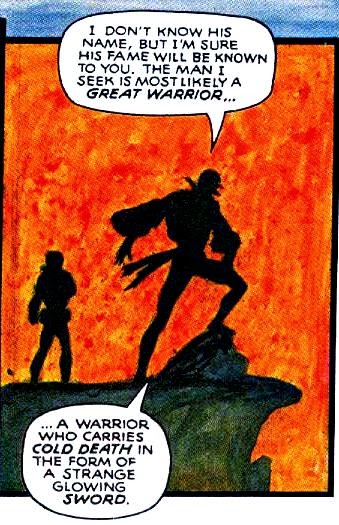Epic Illustrated #3 (Fall 1980) Story & Art by James Starlin
Synopsis: On the icy world of Byfrexia (also known as Vega) a masked man spins around to find Aknaton behind him. He mistakes Aknaton for a Zygotean and fires, but the wizard blocks the blast with a shield and returns fire. When the man is at his mercy, Aknaton is finally able to convince the man he's friendly.
Aknaton explains he's been hanging out around the nearby Zygotean base hoping to come across a certain resistance fighter:
The man knows who Aknaton seeks: Vanth, the Cold Man. He refuses to take the Orisirosian to the Cold Man because he doesn't trust the offworlder. Regretfully (or so he says), Aknaton blasts him and takes control of the man's mind. He commands him to lead the way.
While they walk, he gets the man to tell him Vanth's story. Not only is a Vanth a great warrior and super-strong, but he upgraded their ships to photonic drive. The incident that made a man out of Vanth was the tragic death of his parents at the claws of snowbeasts. He went crazy for a bit and people would see him out on the snows naked. When, he finally returned to civilization, he loaded himself down with weapons and started killing snowbeasts. The people who lived on the snowbeasts didn't like him hunting them to near extinction, so Vanth slipped off-world.
After the Zygotean attack, he returned with off-world weapons. He single-handedly set the Zygoteans back months. He was made commander of all the defense forces.
Suddenly, the man is shot in the head, and Aknaton finds himself surrounded by just-teleported warriors:
Aknaton starts fighting, but there are just too many. Meanwhile, a hooded figure watches the melee from a nearby ridge...
Aknaton explains he's been hanging out around the nearby Zygotean base hoping to come across a certain resistance fighter:
The man knows who Aknaton seeks: Vanth, the Cold Man. He refuses to take the Orisirosian to the Cold Man because he doesn't trust the offworlder. Regretfully (or so he says), Aknaton blasts him and takes control of the man's mind. He commands him to lead the way.
While they walk, he gets the man to tell him Vanth's story. Not only is a Vanth a great warrior and super-strong, but he upgraded their ships to photonic drive. The incident that made a man out of Vanth was the tragic death of his parents at the claws of snowbeasts. He went crazy for a bit and people would see him out on the snows naked. When, he finally returned to civilization, he loaded himself down with weapons and started killing snowbeasts. The people who lived on the snowbeasts didn't like him hunting them to near extinction, so Vanth slipped off-world.
After the Zygotean attack, he returned with off-world weapons. He single-handedly set the Zygoteans back months. He was made commander of all the defense forces.
Suddenly, the man is shot in the head, and Aknaton finds himself surrounded by just-teleported warriors:
Aknaton starts fighting, but there are just too many. Meanwhile, a hooded figure watches the melee from a nearby ridge...
Things to Notice:
Starlin resists the urged to make the masked unknown Aknaton encounter be the very man he seeks.
Vanth's solution to the death of his parents at the hands of a snowbeast (attempting to drive a species to extinction) must appeal to Aknaton. It's not that far from the uncompromising approach his people took to their problem with the Zygoteans and the ruthless way Aknaton "ended" their invasion of earth. Could Vanth be exactly the sort of warrior Aknation is seeking?
- Aknaton doesn't just assert that he's Orsirosian but "of good stock."
Starlin resists the urged to make the masked unknown Aknaton encounter be the very man he seeks.
Vanth's solution to the death of his parents at the hands of a snowbeast (attempting to drive a species to extinction) must appeal to Aknaton. It's not that far from the uncompromising approach his people took to their problem with the Zygoteans and the ruthless way Aknaton "ended" their invasion of earth. Could Vanth be exactly the sort of warrior Aknation is seeking?





















